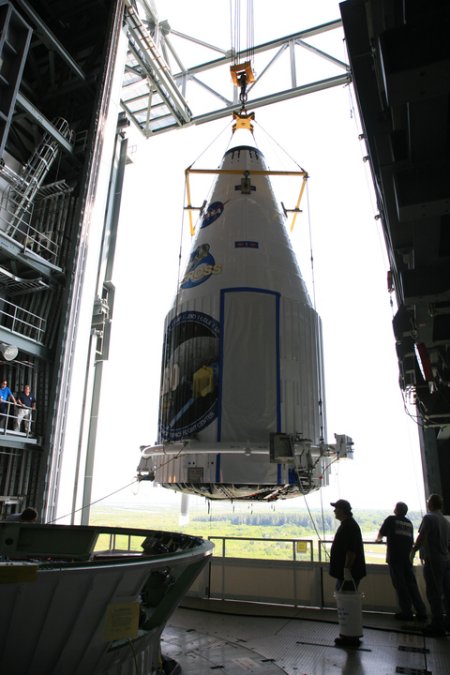NASA’s Lunar Reconnaissance Orbiter, or LRO, and the Lunar Crater Observation and Sensing Satellite, or LCROSS, began their journey to the moon rolled out to launch complex 41 at Cape Canaveral Air Force Center at about 1:30 a.m. EDT on May 28.

The missions are scheduled to launch together aboard an Atlas V rocket on June 17. The satellites will help to set the stage for future lunar exploration and scientific research.
Since the moon is only four days away, we want to use Earth’s closest neighbor to explore before we take bigger steps into the solar system for longer-term exploration.
Just as a scout finds the safest ways for expedition on Earth, NASA will send a robotic scout, LRO, to gather crucial data on the moon’s topography, composition and environment. LRO follows in the footsteps of Ranger, Lunar Orbiter and Surveyor. These predecessors to the Apollo missions searched for the best possible landing sites.

LRO and its seven instruments are designed to find possible landing sites, locate potential resources, characterize the lunar radiation environment, and test new technology. It will create a comprehensive atlas of the moon’s features. After launch, LRO’s journey to the moon will take approximately four days. After about sixty days, LRO will enter its operational circular polar orbit, about 31 miles above the moon’s surface. The data sets gathered by LRO will enable a safe and productive human return to the moon.
LCROSS is a spectacular mission will attempt to determine if water ice occurs in areas of permanent shadow near the lunar poles. LCROSS uses the spent second stage of the Atlas rocket, the Centaur, as an SUV-sized kinetic impactor that will excavate a small crater on the floor of a permanently shadowed lunar crater. The Centaur has never been used in this way before. The LCROSS spacecraft will fly through the Centaur impact plume to search for signs of water ice before impacting the lunar surface and creating a second debris plume. Both plumes and their resulting craters will be observed closely by LCROSS mission scientists and astronomers around the world.

LCROSS represents a new generation of fast development, cost-capped missions that use off-the-shelf hardware and flight-proven software to achieve focused mission goals. Whatever the mission discovers about the presence of water will increase our knowledge of the mineral makeup of the most remote areas of the moon, the deep polar craters where sunshine never reaches.
More pictures: http://mediaarchive.ksc.nasa.gov/search.cfm?cat=201
More about LRO: https://www.nasa.gov/lro
More about LCROSS: https://www.nasa.gov/lcross






